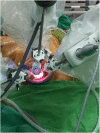Selection of minimally invasive surgical approaches for treating esophageal cancer
- PMID: 35702945
- PMCID: PMC9346190
- DOI: 10.1111/1759-7714.14533
Selection of minimally invasive surgical approaches for treating esophageal cancer
Abstract
Minimally invasive esophagectomy has gradually been accepted as an active treatment option for surgery of esophageal cancer. However, there is no consensus about how to perform the procedures in the thoracic and abdominal phase including anastomosis in the neck (McKeown) or chest (Ivor Lewis), VATS, robotic-assisted or reduced port approaches or various endoscopic abrasion techniques. Further studies to investigate the roles of these novel techniques are required to treat the various patient populations.
Keywords: VATS; esophageal submucosal dissection; minimally invasive esophagectomy; photodynamic therapy (PDT); robotic surgery.
© 2022 The Authors. Thoracic Cancer published by China Lung Oncology Group and John Wiley & Sons Australia, Ltd.
Conflict of interest statement
The authors did not receive any financial support for this study.
Figures




Similar articles
-
Minimally Invasive Esophageal Cancer Surgery.Surg Oncol Clin N Am. 2019 Apr;28(2):177-200. doi: 10.1016/j.soc.2018.11.009. Epub 2019 Feb 2. Surg Oncol Clin N Am. 2019. PMID: 30851822 Review.
-
End to side circular stapled anastomosis during robotic-assisted Ivor Lewis minimally invasive esophagectomy (RAMIE).Dis Esophagus. 2022 Aug 13;35(8):doab088. doi: 10.1093/dote/doab088. Dis Esophagus. 2022. PMID: 34979549
-
A Single Intercostal Space Thoracoscopic Approach for Minimally Invasive Ivor Lewis Esophagectomy.J Laparoendosc Adv Surg Tech A. 2017 Nov;27(11):1198-1202. doi: 10.1089/lap.2017.0147. Epub 2017 May 15. J Laparoendosc Adv Surg Tech A. 2017. PMID: 28504587
-
[Clinical observation on perioperative complications of minimally invasive Ivor-Lewis and minimally invasive McKeown esophagectomy].Zhonghua Zhong Liu Za Zhi. 2022 Jun 23;44(6):577-580. doi: 10.3760/cma.j.cn112152-20200704-00626. Zhonghua Zhong Liu Za Zhi. 2022. PMID: 35754233 Chinese.
-
Ivor Lewis Minimally Invasive Esophagectomy - What Do We Choose? Literature Review.Chirurgia (Bucur). 2022 Apr;117(2):164-174. doi: 10.21614/chirurgia.2724. Chirurgia (Bucur). 2022. PMID: 35535777 Review.
Cited by
-
Novel Mediastinoscope-Assisted Minimally Invasive Esophagectomy for Esophageal Cancer: A Systematic Review and Meta-analysis.Ann Surg Oncol. 2023 Jul;30(7):4030-4039. doi: 10.1245/s10434-023-13264-2. Epub 2023 Feb 23. Ann Surg Oncol. 2023. PMID: 36820939
-
Artificial intelligence for intraoperative video analysis in robotic-assisted esophagectomy.Surg Endosc. 2025 May;39(5):2774-2783. doi: 10.1007/s00464-025-11685-6. Epub 2025 Mar 31. Surg Endosc. 2025. PMID: 40164839 Free PMC article. Review.
-
Long-Term Results of Single- and Multi-Incision Minimally Invasive Esophagectomy for Esophageal Cancer: Experience of 348 Cases.Biomedicines. 2025 Jun 21;13(7):1523. doi: 10.3390/biomedicines13071523. Biomedicines. 2025. PMID: 40722599 Free PMC article.
-
Telestration with augmented reality improves the performance of the first ten ex vivo porcine laparoscopic cholecystectomies: a randomized controlled study.Surg Endosc. 2023 Oct;37(10):7839-7848. doi: 10.1007/s00464-023-10360-y. Epub 2023 Aug 23. Surg Endosc. 2023. PMID: 37612445 Free PMC article. Clinical Trial.
-
Single staged repair of an anastomotic tracheal fistula following Mckeown esophagectomy via cervical incision: a case report.J Cardiothorac Surg. 2025 Apr 22;20(1):217. doi: 10.1186/s13019-025-03430-w. J Cardiothorac Surg. 2025. PMID: 40264177 Free PMC article.
References
-
- Decker G, Coosemans W, De Leyn P, et al. Minimally invasive esophagectomy for cancer. Eur J Cardiothorac Surg. 2009;35(1):13–20. discussion 20‐1. - PubMed
-
- Biere SS, van Berge Henegouwen MI, Maas KW, et al. Minimally invasive versus open oesophagectomy for patients with oesophageal cancer: a multicentre, open‐label, randomised controlled trial. Lancet. 2012;379(9829):1887–92. - PubMed
-
- Guo W, Ma X, Yang S, et al. Combined thoracoscopic‐laparoscopic esophagectomy versus open esophagectomy: a meta‐analysis of outcomes. Surg Endosc. 2016;30(9):3873–81. - PubMed
Publication types
MeSH terms
LinkOut - more resources
Full Text Sources
Medical

